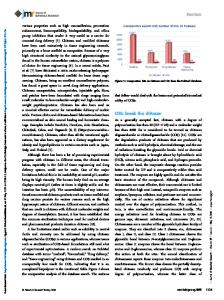Potential Applications of Graphene-Based Nanomaterials in Biomedical, Dental, and Implant Applications
Graphene-based materials have gained extensive attention in the field of research seeking novel materials for biomedicine, dentistry, and implantology due to their unique physicochemical properties, high strength, thermal stability, electrical conductivit
- PDF / 20,249,124 Bytes
- 422 Pages / 439.371 x 683.151 pts Page_size
- 68 Downloads / 365 Views
nces in Dental Implantology using Nanomaterials and Allied Technology Applications
Advances in Dental Implantology using Nanomaterials and Allied Technology Applications
Ramesh S. Chaughule • Rajesh Dashaputra Editors
Advances in Dental Implantology using Nanomaterials and Allied Technology Applications
Editors Ramesh S. Chaughule Department of Chemistry Ramnarain Ruia Autonomous College Matunga, Mumbai, India
Rajesh Dashaputra Department of Dentistry Bhabha Atomic Research Center Hospital Mumbai, India
ISBN 978-3-030-52206-3 ISBN 978-3-030-52207-0 (eBook) https://doi.org/10.1007/978-3-030-52207-0 © Springer Nature Switzerland AG 2021 This work is subject to copyright. All rights are reserved by the Publisher, whether the whole or part of the material is concerned, specifically the rights of translation, reprinting, reuse of illustrations, recitation, broadcasting, reproduction on microfilms or in any other physical way, and transmission or information storage and retrieval, electronic adaptation, computer software, or by similar or dissimilar methodology now known or hereafter developed. The use of general descriptive names, registered names, trademarks, service marks, etc. in this publication does not imply, even in the absence of a specific statement, that such names are exempt from the relevant protective laws and regulations and therefore free for general use. The publisher, the authors, and the editors are safe to assume that the advice and information in this book are believed to be true and accurate at the date of publication. Neither the publisher nor the authors or the editors give a warranty, expressed or implied, with respect to the material contained herein or for any errors or omissions that may have been made. The publisher remains neutral with regard to jurisdictional claims in published maps and institutional affiliations. This Springer imprint is published by the registered company Springer Nature Switzerland AG The registered company address is: Gewerbestrasse 11, 6330 Cham, Switzerland
Foreword
I am glad to write a foreword for this book “Advances in Dental Implantology using Nanomaterials and Allied Technology Applications” to be published by Springer, USA, that focuses on the use of nanotechnology in dentistry and particularly in the field of implants. This book, edited by Drs. Ramesh S. Chaughule and Rajesh Dashaputra, presents a collection of topics from eminent authors across the globe on the use of nanobiomaterials for implantology and their clinical applications. Nanotechnology is a new field that has enormous scope in the dental science. One can make use of it in understanding and achieving cell-specific functions. Nanoscale surface morphology augments the surface area and thus provides an increased implant surface area that can react to the biologic environment. The composition of dental implants, surface energy, and roughness and topography can be improved for better osseointegration, and cellular activities and tissue responses occurring at the bone–implant interface ca
Data Loading...











